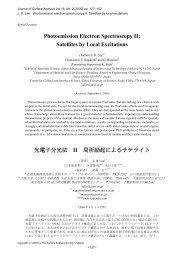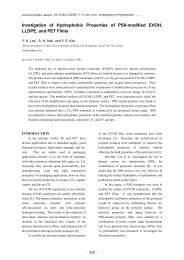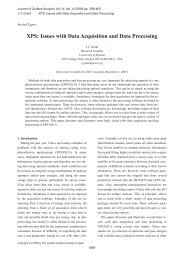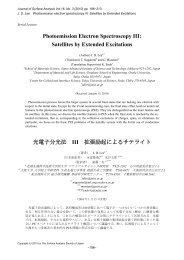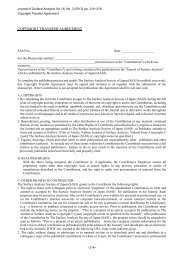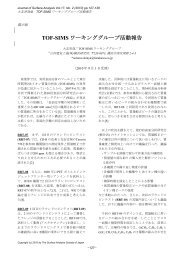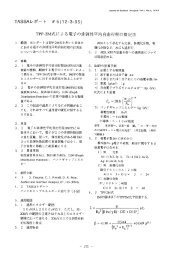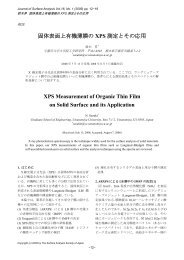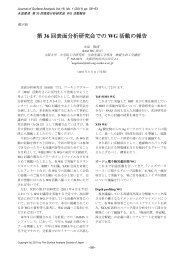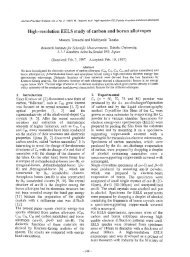Vol.15 No.2 150-158.pdf
Vol.15 No.2 150-158.pdf
Vol.15 No.2 150-158.pdf
Create successful ePaper yourself
Turn your PDF publications into a flip-book with our unique Google optimized e-Paper software.
Journal of Surface Analysis <strong>Vol.15</strong>, No. 2 (2008) pp. <strong>150</strong>−158<br />
T. Nagatomi et al. Inelastic Interaction of Medium-Energy Electrons with Ni Surface Studied by Absolute<br />
Reflection Electron Energy Loss Spectrum Analysis and Monte Carlo Simulation<br />
The scattering angle φ is determined by the random<br />
number R 2 as<br />
R<br />
2<br />
φ<br />
∫0<br />
=<br />
π<br />
∫<br />
0<br />
dσ<br />
dφ′<br />
dσ<br />
dφ′<br />
elastic<br />
elastic<br />
dφ′<br />
dφ′<br />
(10)<br />
where dσ elastic /dφ is the differential elastic scattering<br />
cross section. The elastic mean free path and differential<br />
elastic scattering cross section were calculated using<br />
Mott cross sections calculated with the partial-wave expansion<br />
method using the Thomas-Fermi-Dirac potential<br />
[36-38].<br />
4.2. Model II (with inelastic scattering)<br />
In Model II, the inelastic scattering due to both bulk<br />
and surface excitations are taken into account as the type<br />
of scattering in order to simulate REELS spectra. The<br />
step length Λ between two successive collision events in<br />
the bulk is determined using eq. (11) instead of (9)<br />
( )<br />
= −λ total ln R 3<br />
Λ<br />
-1 -1 -1<br />
total<br />
= λelastic<br />
λb<br />
where λ total is the total mean free path given by,<br />
λ +<br />
(11)<br />
. (12)<br />
The type of scattering is determined by another random<br />
number R 4 as<br />
-1 -1<br />
⎧ elastic, for R4<br />
< λ<br />
elastic<br />
λtotal<br />
. (13)<br />
⎨<br />
⎩inelastic<br />
otherwise<br />
When the type of scattering is the elastic collision, the<br />
scattering angle is determined as that in Model I described<br />
above. When the type of scattering is the inelastic<br />
collision, the amount of the energy loss ΔE by bulk excitation<br />
is determined by<br />
R<br />
=<br />
ΔE<br />
∫0<br />
∫<br />
5 Ep<br />
0<br />
λ K<br />
b<br />
λ K<br />
b<br />
b<br />
b<br />
( ΔE′<br />
) d(<br />
ΔE′<br />
)<br />
( ΔE′<br />
) d( ΔE′<br />
)<br />
. (14)<br />
Details of the MC modeling of REELS spectra, where<br />
only bulk excitations are taken into account as inelastic<br />
collisions, are described elsewhere [39,40].<br />
In order to describe energy losses by surface excitations<br />
in MC simulation, the Poisson stochastic process<br />
was assumed. Signal electrons undergo surface excitations<br />
when they cross the surface on their incoming and<br />
outgoing ways. The numbers of surface excitation events<br />
experienced by incident and backscattered electrons<br />
crossing the surface on their incoming and outgoing trajectories,<br />
L in and L out , respectively, are determined by<br />
P l k<br />
L −1<br />
k<br />
∑<br />
l=<br />
0<br />
∞<br />
∑<br />
l=<br />
0<br />
p<br />
p<br />
k<br />
l<br />
k<br />
l<br />
< R<br />
6<br />
<<br />
L<br />
k<br />
∑<br />
l=<br />
0<br />
∞<br />
∑<br />
l=<br />
0<br />
p<br />
p<br />
k<br />
l<br />
k<br />
l<br />
(15)<br />
is the probability that the electron participates in<br />
l-fold surface excitation events on its incoming (k=in)<br />
and outgoing (k=out) trajectories. P l k satisfies the relation<br />
∑ ∞<br />
k<br />
p l<br />
l=0<br />
= 1<br />
(16)<br />
and expressed using SEP for incoming and outgoing<br />
electrons, P in s and P out s , by<br />
p<br />
k<br />
l<br />
k l<br />
k<br />
( P ) ( − P<br />
1<br />
=<br />
s<br />
exp<br />
s<br />
) . (17)<br />
l !<br />
The amount of the energy loss ΔE by a single surface<br />
excitation event is determined using<br />
R<br />
=<br />
ΔE<br />
∫0<br />
∫<br />
7 Ep<br />
0<br />
k −1<br />
k<br />
( P ) ( ′) ( ′<br />
s<br />
K<br />
s<br />
ΔE<br />
d ΔE<br />
)<br />
k −1<br />
k<br />
( P ) K ( ΔE′<br />
) d( ΔE′<br />
)<br />
s<br />
s<br />
. (18)<br />
Here, P in s and P out s , and K in s (ΔE) and K out s (ΔE) are assumed<br />
to satisfy the relations<br />
in<br />
( ΔE) = Θ( θ ) K ( ΔE)<br />
out<br />
Ks in<br />
,θ<br />
P<br />
out<br />
( θ ) in<br />
out<br />
s<br />
= Θ θ<br />
in<br />
,<br />
out<br />
Ps<br />
s<br />
(19)<br />
. (20)<br />
In the case of the multiple surface excitation (L in ≥2 or<br />
L out ≥2), the total amount of energy loss due to L k -fold<br />
surface excitation events is calculated by repeating the<br />
calculation of eq. (18) L k times.<br />
In the model II of the MC simulation, the values of the<br />
IMFP λ b , SEP P k s and DSEP K k s (ΔE), are described by<br />
those absolutely determined by the present REELS<br />
analysis. During the transport of a signal electron in solids,<br />
the mean free path, elastic cross section, DIMFP,<br />
SEP and DSEP are changed depending on the kinetic<br />
energy of the electron. In the present MC simulation,<br />
however, we significantly reduced the calculation time<br />
by assuming that the values of those parameters for the<br />
certain primary energy can be used during calculating a<br />
−153−



